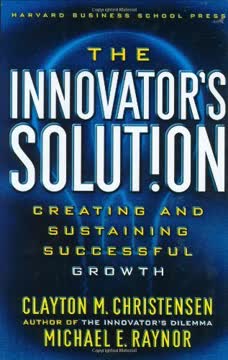Key Takeaways
1. Market-creating innovations drive prosperity by serving nonconsumers
Market-creating innovations transform complicated and expensive products and services into simple and more affordable products, making them accessible to a whole new segment of people in a society whom we call "nonconsumers."
Nonconsumption as opportunity. In many developing countries, vast segments of the population are nonconsumers of products and services that are taken for granted in developed economies. This represents an enormous untapped market and opportunity for innovation. By creating new markets that serve nonconsumers, companies can:
- Generate sustainable economic growth and job creation
- Pull in necessary infrastructure and institutional development
- Catalyze a virtuous cycle of increasing prosperity
Examples:
- Mo Ibrahim's Celtel bringing mobile communications to Africa
- Tolaram's Indomie noodles creating a new food market in Nigeria
- M-PESA mobile money platform in Kenya enabling financial inclusion
2. Struggle signals opportunity for transformative innovation
In the struggle lies opportunity.
Reframe challenges as possibilities. When examining a market, look beyond conventional metrics to identify the daily struggles and workarounds people employ. These pain points signal unmet needs and opportunities to create new markets through innovation.
Key principles for targeting nonconsumption:
- Focus on making products simpler, more affordable, and more accessible
- Develop new business models and value networks to serve nonconsumers
- Use an emergent strategy to learn and adapt to market needs
Case study: MicroEnsure created a new market for microinsurance in developing countries by radically simplifying the product and sign-up process to meet the needs of nonconsumers.
3. Pull strategies outperform push strategies in sustainable development
Pull strategies ensure a ready market is waiting. This, we believe, is essential for long-term and sustainable prosperity.
Market demand drives development. Traditional "push" strategies that attempt to impose solutions often fail to take root. Instead, "pull" strategies that respond to market demand are more likely to create lasting change:
- Innovations create new markets that pull in supporting infrastructure and institutions
- Local entrepreneurs are best positioned to identify and meet market needs
- Pulled resources are more likely to be maintained as they serve a clear purpose
Contrasting approaches:
- Push: Building toilets in India without addressing underlying market dynamics
- Pull: M-PESA mobile money creating demand that pulled in financial regulations and infrastructure
4. Innovation precedes and shapes effective institutions and infrastructure
Institutions are not something that can be pushed in by virtue of good intentions, even with all the expertise in the world.
Markets mold institutions. Contrary to conventional wisdom, effective institutions and infrastructure typically follow market-creating innovations rather than precede them. As new markets emerge:
- They create economic incentives to develop supporting institutions
- Infrastructure is pulled in to meet market needs
- Regulations evolve to govern new market realities
Historical examples:
- US railroad development driven by market demand, not central planning
- Venetian financial innovations shaping legal and political institutions
Modern case study: How Tolaram's noodle business in Nigeria pulled in manufacturing, logistics, and retail infrastructure.
5. Corruption diminishes as market-creating innovations proliferate
Corruption is not primarily about the lack of good leadership. Although that's certainly part of it, the causal factors are far more fundamental. Corruption is about "hiring" the most expedient solution for what seems to be, in the moment, the greatest good of the options available to us.
Markets create alternatives to corruption. Rather than focusing solely on anti-corruption measures, fostering market-creating innovations can organically reduce corruption by:
- Providing economic opportunities that reduce incentives for corruption
- Creating stakeholders invested in transparent, well-functioning markets
- Pulling in institutions and infrastructure that enable legitimate business
Stages of corruption evolution:
- Overt and unpredictable
- Covert and predictable
- Transparent society
Case study: How South Korea transitioned from widespread corruption to a more transparent society through economic development and market creation.
6. Reframe problems to unlock innovative solutions
Most of the things worth doing in the world had been declared impossible before they were done.
Question assumptions to find breakthroughs. Many seemingly intractable problems can be solved by reframing the challenge and asking different questions. This opens up new avenues for innovation.
Strategies for reframing:
- Look at problems through the lens of nonconsumption
- Question industry orthodoxies and "best practices"
- Consider the underlying Job to Be Done rather than existing product categories
Example: How the Wright brothers succeeded in manned flight by reframing the problem around balance and control rather than just propulsion.
7. Prosperity is a process fueled by continuous market-creating innovation
Innovation really does change the world.
Sustain progress through ongoing innovation. Creating prosperity is not a one-time event but an ongoing process of market creation and expansion. To drive sustainable development:
- Foster a culture of innovation and entrepreneurship
- Continually identify and target areas of nonconsumption
- Develop processes to scale and replicate successful market-creating innovations
Case studies of ongoing innovation:
- How Aravind Eye Care System and Narayana Health continue to innovate in healthcare delivery
- The evolution of mobile technology markets in Africa from basic communication to fintech and beyond
Key principles for market-creating innovators:
- Look for nonconsumption opportunities in every product category
- Create whole systems, not just products
- Focus on pulling resources rather than pushing solutions
- Scale by targeting large areas of nonconsumption
</most_relevant_traits>
Last updated:
FAQ
What's The Prosperity Paradox about?
- Economic Development Focus: The book examines why some nations escape poverty while others remain trapped, highlighting the role of market-creating innovations in driving economic growth.
- Innovation as a Catalyst: It argues that true prosperity comes from creating new markets that empower individuals and communities, rather than just alleviating poverty.
- Case Studies and Insights: Through examples from countries like South Korea, Japan, and Mexico, the book illustrates how different strategies and innovations have led to significant economic transformations.
Why should I read The Prosperity Paradox?
- Challenging Conventional Wisdom: The book offers a fresh perspective on economic development, encouraging readers to rethink traditional poverty alleviation methods.
- Practical Frameworks: It provides insights into different types of innovations—sustaining, efficiency, and market-creating—and their varying impacts on economies.
- Inspiring Examples: The authors share stories of entrepreneurs who have successfully created markets in challenging environments, offering hope and actionable lessons.
What are the key takeaways of The Prosperity Paradox?
- Market-Creating Innovations: These are essential for sustainable economic growth, democratizing access to products and services and enabling broader economic participation.
- Focus on Nonconsumption: Targeting nonconsumption—people lacking access to essential goods—can unlock significant market potential and create new markets.
- Pull vs. Push Strategies: The book advocates for pull strategies that respond to market demands, ensuring effective resource utilization and sustainable development.
What is the Prosperity Paradox?
- Definition: It refers to the phenomenon where efforts to alleviate poverty can inadvertently lead to greater inequality and nonconsumption.
- Cycle of Poverty: Focusing solely on efficiency innovations can perpetuate poverty, benefiting only those already well-off, while market-creating innovations can break this cycle.
- Historical Context: The book uses examples like South Korea's transformation to show how nations can overcome the paradox through innovative thinking and market development.
What are market-creating innovations according to The Prosperity Paradox?
- Definition: These innovations make previously expensive or inaccessible goods affordable and available to a broader population, targeting nonconsumers.
- Examples: Innovations like Celtel in Africa and Narayana Health in India demonstrate how these innovations create new markets and stimulate economic growth.
- Impact on Society: By focusing on market-creating innovations, societies can address fundamental issues like healthcare and education, leading to sustainable prosperity.
How does The Prosperity Paradox define prosperity?
- Process of Improvement: Prosperity is defined as the process by which more people improve their economic, social, and political well-being, beyond mere wealth accumulation.
- Access to Employment: Gainful employment and upward social mobility are critical indicators of prosperity, emphasizing the importance of job creation.
- Sustainable Development: True prosperity fosters a culture of innovation and inquiry, supporting long-term growth without relying on singular resources.
What are the different types of innovations discussed in The Prosperity Paradox?
- Sustaining Innovations: These improve existing products for current consumers, maintaining competitiveness but not creating new markets.
- Efficiency Innovations: They allow companies to do more with fewer resources, often leading to cost savings but limited long-term economic impact.
- Market-Creating Innovations: These transform complex products into affordable solutions for nonconsumers, crucial for creating new markets and driving sustainable development.
How does The Prosperity Paradox address the issue of corruption?
- Corruption as a Solution: The book suggests corruption persists as a workaround in environments with limited legitimate options, requiring a broader understanding for effective strategies.
- Phases of Corruption: It outlines three phases—overt, covert, and transparent—helping to understand societal evolution towards transparency.
- Role of Innovation: Market-creating innovations can reduce corruption by providing legitimate opportunities, decreasing reliance on corrupt practices.
What role do institutions play in economic development according to The Prosperity Paradox?
- Institutions Reflect Culture: Effective institutions emerge from successful market-creating innovations that address local needs, rather than being imposed.
- Importance of Local Context: Imposing foreign institutions without understanding local context often leads to failure; sustainable institutions must be culturally rooted.
- Sequential Development: Market-creating innovations often precede strong institutions, which develop as economies grow and prosper.
How can individuals and organizations apply the concepts from The Prosperity Paradox?
- Identify Nonconsumption Opportunities: Look for areas with significant nonconsumption to identify opportunities for market-creating innovations.
- Focus on Processes: Develop organizational processes that prioritize efficiency and effectiveness in delivering value to scale impact.
- Engage with Local Communities: Building relationships with local populations is essential for understanding their needs and developing effective solutions.
What are the best quotes from The Prosperity Paradox and what do they mean?
- “In the struggle lies opportunity.”: Challenges can reveal significant market opportunities for innovation and growth.
- “Poverty Stops Here”: Alleviating poverty is not enough; creating sustainable prosperity requires innovative solutions that empower communities.
- “Markets are creations.”: Markets must be actively created through innovation and entrepreneurial efforts, rather than simply existing.
What are the implications of The Prosperity Paradox for policymakers?
- Support Market Creation: Policymakers should focus on fostering market-creating innovations rather than solely pushing for institutional reforms.
- Invest in Local Solutions: Encourage local entrepreneurs to develop solutions addressing community-specific needs, building capacity and resilience.
- Reframe Development Goals: Shift focus from traditional metrics to those prioritizing innovation and market creation for effective poverty reduction and prosperity promotion.
Review Summary
The Prosperity Paradox receives mostly positive reviews, praised for its insightful analysis of market-creating innovations and their potential to alleviate poverty. Readers appreciate Christensen's examples and case studies, finding the book thought-provoking and well-structured. Some critics argue that the book oversimplifies complex issues and overlooks historical factors. The corruption chapter and the focus on bottom-up innovation are highlighted as particularly interesting. Overall, reviewers find the book's perspective on economic development refreshing and valuable.
Similar Books










Download PDF
Download EPUB
.epub digital book format is ideal for reading ebooks on phones, tablets, and e-readers.












